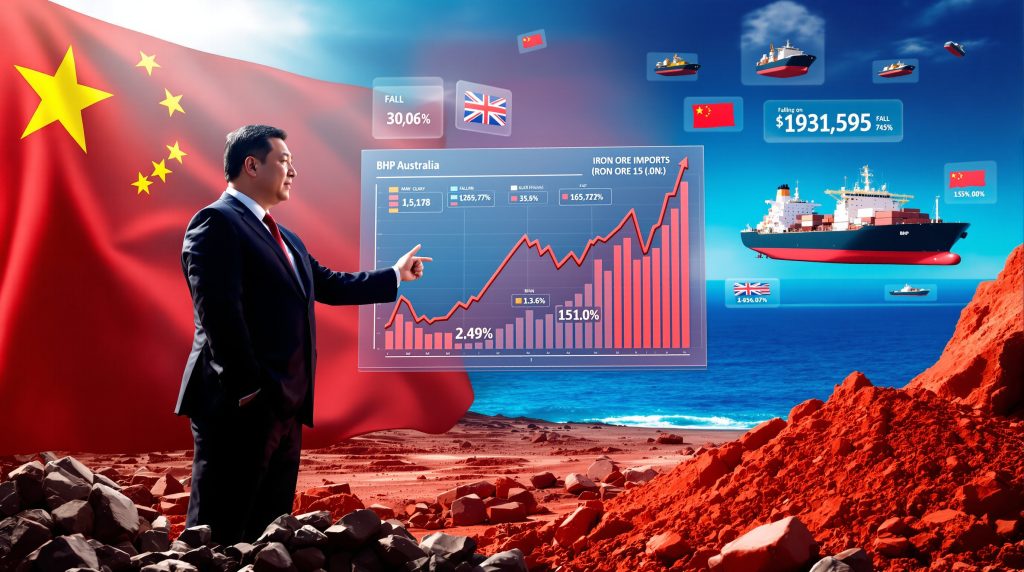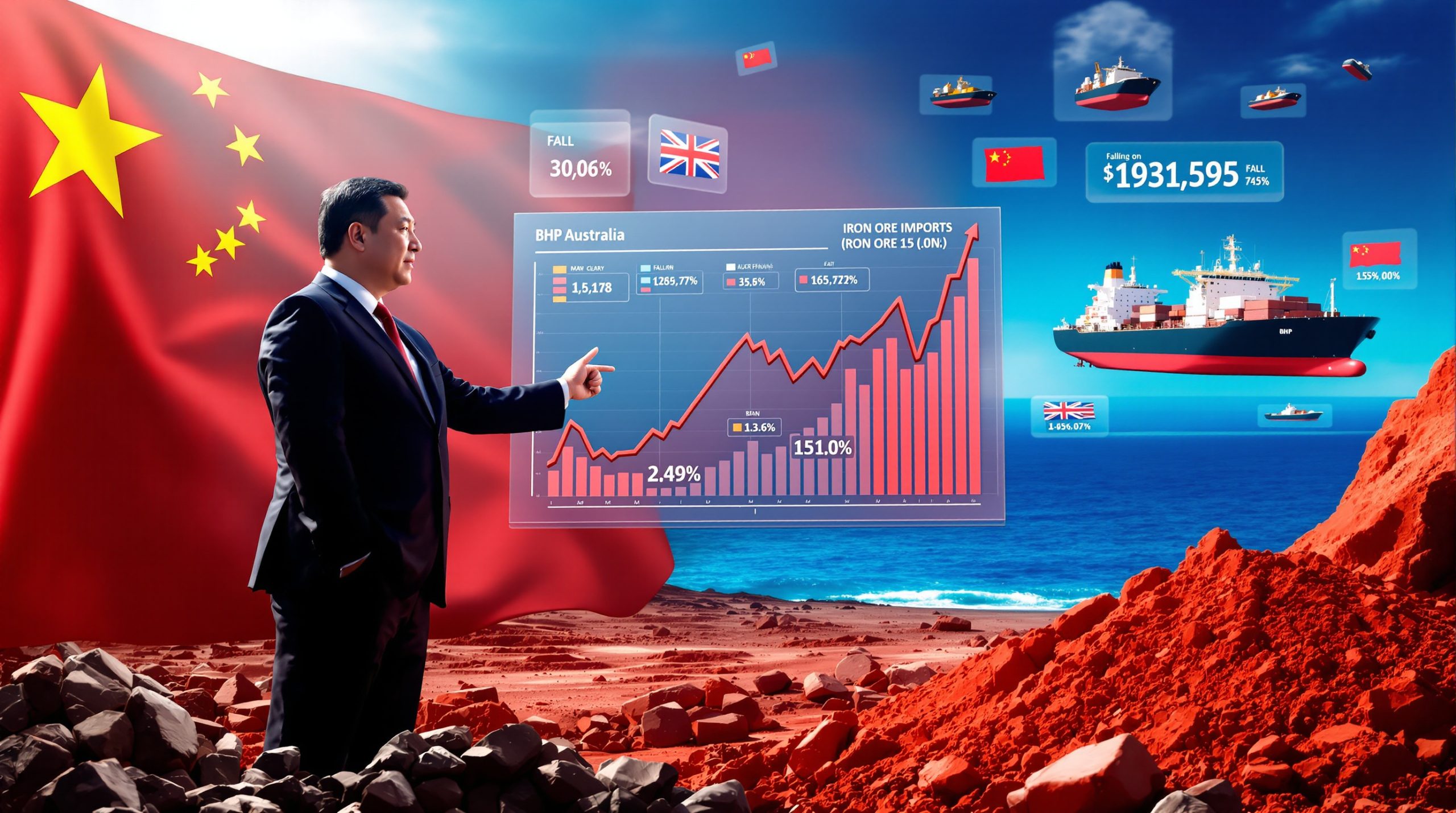China's Ban on BHP Iron Ore Imports: Understanding the Commercial Dispute
In a significant development for global commodity markets, reports emerged in late September 2025 that China may have imposed restrictions on iron ore imports from mining giant BHP. This apparent commercial dispute has raised concerns about the potential impacts on Australia's resource exports and broader trade relations between the two nations. While officials describe the situation as primarily a pricing negotiation between companies, it represents an important test case for how Australia and China manage commercial tensions in their complex economic relationship. Furthermore, the iron ore price trends are likely to be significantly affected by this development.
What Is Happening With China's Ban on BHP Iron Ore?
Current Situation and Official Statements
Reports of China restricting iron ore imports from BHP first emerged when Bloomberg published an article claiming that China's state iron ore buyer had directed steelmakers to pause purchases from the mining giant. This news immediately impacted markets, with BHP shares dropping 1.1% to $42.05 following the announcement.
The reported ban appears linked to ongoing pricing negotiations between BHP and China Mineral Resources Group (CMRG), China's state-backed iron ore purchasing entity. However, conflicting information emerged when Chinese commodity analysis firm Mysteel later contradicted Bloomberg's report, stating no such directive had been issued by CMRG.
When approached for comment, BHP declined to provide details about the ongoing negotiations, maintaining a strategic silence while the situation develops. According to reports from Reuters, the dispute has been escalating for several weeks.
Timeline of Recent Developments
The apparent dispute developed rapidly in late September 2025, when CMRG reportedly issued directives to suspend new dollar-denominated iron ore purchases from BHP. Importantly, existing shipments already en route from Australia continue to be delivered, suggesting this is not a complete embargo but rather a negotiating tactic.
In response to the reports, Australian government officials quickly initiated discussions with BHP leadership to understand the situation. Prime Minister Anthony Albanese publicly addressed the issue on October 1, 2025, expressing concern while calling for markets to "operate properly" without hindrance.
Treasurer Jim Chalmers described the reports as "concerning" and announced plans to speak with BHP CEO Mike Henry about the developing situation. The government's rapid response underscores the economic significance of iron ore exports to Australia's economy.
Why Is China Targeting BHP's Iron Ore Imports?
Pricing Disputes and Negotiation Tactics
The core of the dispute appears to center on disagreements over pricing terms for medium-grade iron ore. Prime Minister Albanese suggested the ban might be a negotiating tactic rather than a permanent measure, noting: "Sometimes when people are negotiating over price, sometimes these things will occur."
Commercial negotiations in the iron ore sector often involve complex discussions around pricing structures, contract terms, and supply commitments. What makes this case notable is CMRG's apparent willingness to leverage its considerable purchasing power to secure more favorable terms from one of the world's largest iron ore mines.
Industry analysts suggest that CMRG may be testing its market strength by targeting BHP specifically, potentially to establish new precedents for future negotiations with other suppliers. The timing aligns with a period of fluctuating iron ore prices, creating an environment where buyers may feel empowered to push for better terms.
China's Strategic Positioning in Iron Ore Markets
CMRG was established by Beijing in 2020 with the explicit purpose of consolidating China's iron ore purchasing power. This centralization strategy aims to help China, the world's largest steel producer, gain greater control over iron ore pricing in global markets.
China's steel industry consumes approximately 70% of global iron ore seaborne trade, giving it significant market influence. By coordinating purchases through CMRG, Chinese authorities aim to counterbalance the market power of major mining companies like BHP, Rio Tinto, and Vale, which together control a large portion of global iron ore exports.
This latest dispute may represent CMRG flexing its muscles as it matures into its role as China's centralized procurement entity. After several years of operation, the organization appears increasingly confident in using its market position as leverage against major suppliers.
How Does This Compare to Previous China-Australia Trade Tensions?
Historical Context of Economic Coercion
When addressing the current situation, Prime Minister Albanese made specific reference to "China's past campaign of economic coercion against the Morrison government." This referred to a period from 2020-2022 when China imposed restrictions on various Australian exports including coal, wine, barley, and lobster amid deteriorating diplomatic relations.
Those earlier trade actions were widely interpreted as politically motivated responses to Australia's policies, including calls for an investigation into the origins of COVID-19 and restrictions on Chinese technology companies. They affected multiple export sectors simultaneously and came amid explicitly strained diplomatic relations.
The current iron ore dispute, by contrast, appears more narrowly focused on commercial terms between specific entities rather than broader political objectives. Both Australian government officials and industry analysts have characterized the situation as primarily a business negotiation rather than a return to previous patterns of economic coercion.
Market-Based vs. Political Motivations
Treasurer Chalmers emphasized this distinction when he described the current situation as involving "commercial arrangements between two companies." This framing suggests the government views the dispute through an economic rather than diplomatic lens.
Several factors support this commercial interpretation. First, iron ore remained largely untouched during previous periods of trade tension, likely due to China's heavy dependence on Australian supply. Second, the dispute centers specifically on BHP rather than all Australian miners. Finally, it coincides with legitimate pricing negotiations rather than political disagreements.
Market analysts note that China has become more sophisticated in how it manages its resource dependencies, preferring to work within commercial frameworks rather than imposing blunt restrictions that might harm its own industrial interests. This evolution represents an important development in how China deploys its economic influence.
What Are the Economic Implications for Australia?
Impact on BHP and the Mining Sector
As the world's largest listed mining company, BHP plays a crucial role in Australia's export economy. The company's iron ore operations, primarily located in Western Australia's Pilbara region, represent a significant portion of its business activities and contribute substantially to Australian export revenues.
The immediate market reaction to the reported ban was relatively measured, with BHP shares declining just 1.1% following the news. This suggests investors view the situation as a temporary negotiating phase rather than a fundamental threat to the company's business model or Australia's iron ore leadership.
Earlier in 2025, BHP had already announced cuts to exploration spending, partly in response to slowing Chinese demand affecting iron ore prices. This context indicates that broader market conditions were already challenging before the current dispute emerged.
For Australia's wider mining sector, the situation creates uncertainty about whether similar tactics might be employed in negotiations with other producers. Companies like Rio Tinto and Fortescue Metals Group will be closely monitoring how the BHP dispute resolves as it may set precedents for their own future dealings with CMRG.
Broader Economic Considerations
Iron ore remains Australia's single most valuable export commodity, generating approximately $120 billion in annual export revenue in recent years. This represents roughly 25% of Australia's total goods exports, making it a critical contributor to national economic performance.
The sector also generates significant government revenue through royalties and corporate taxes, while supporting thousands of direct and indirect jobs, particularly in Western Australia. Any sustained disruption to iron ore exports would have cascading effects through the Australian economy.
However, the current dispute appears unlikely to significantly impact Australia's broader economic outlook. The targeted nature of the reported ban, focused specifically on new contracts with one company rather than existing shipments or all Australian producers, limits its immediate economic impact.
How Might This Affect Global Iron Ore Markets?
Supply Chain Disruptions and Alternatives
If Chinese steelmakers do indeed pause new purchases from BHP, they would need to rely more heavily on alternative suppliers like Rio Tinto, Vale (Brazil), and Fortescue. However, each of these alternatives comes with considerations regarding quality, reliability, and cost.
Brazilian iron ore, while high in quality, involves longer shipping distances and higher freight costs compared to Australian supply. Additionally, Vale has faced production challenges following dam disasters in recent years, limiting its ability to rapidly increase supply.
Other Australian producers could potentially benefit from increased orders if Chinese buyers shift away from BHP. However, their capacity to immediately scale up production may be limited by infrastructure constraints and existing supply commitments.
For Chinese steelmakers, finding suitable replacement volumes on short notice could potentially increase their input costs, especially if they need to source from more distant suppliers or accept lower-quality ore that requires additional processing.
Price Volatility and Market Responses
Iron ore markets have historically been sensitive to news of supply disruptions or major purchasing changes. The reported ban initially created uncertainty, but price movements remained relatively contained as market participants assessed the situation's actual impact.
Traders are likely considering several factors: the temporary nature of the reported restrictions, the continued flow of existing shipments, and the commercial rather than political character of the dispute. These elements suggest a resolution is likely once pricing terms are agreed upon.
The situation highlights how the iron ore market has evolved in recent years. While still dominated by a handful of major suppliers and China as the dominant buyer, trading has become more sophisticated with greater use of spot markets, futures contracts, and differentiated pricing for various ore grades and qualities.
What Are China's Strategic Objectives?
CMRG's Role in China's Resource Strategy
China Mineral Resources Group represents a strategic initiative by Chinese authorities to reshape how the country secures essential industrial inputs. By consolidating purchasing power that was previously distributed across numerous state-owned steel companies, CMRG aims to enhance China's negotiating position vis-à-vis major mining companies.
The organization's mandate extends beyond simply securing lower prices. It also seeks to establish more stable and predictable pricing mechanisms, reduce market volatility, and ensure long-term supply security for China's massive steel industry.
CMRG operates within China's broader industrial policy framework, which emphasizes self-sufficiency in critical supply chains while maintaining strategic leverage in areas where complete self-sufficiency is impractical. For iron ore, where China remains heavily import-dependent, this means maximizing buying power while gradually developing alternative sources.
Balancing Economic and Political Considerations
China's approach to resource procurement increasingly reflects a sophisticated balancing of multiple objectives. While securing favorable pricing remains paramount, Chinese authorities also consider supply security, quality requirements, and broader trade relationships.
Despite periodic tensions, Australia remains China's largest iron ore supplier due to its reliability, quality consistency, and geographic proximity. Complete disengagement from Australian iron ore would be economically damaging to China's steel industry, limiting the likelihood of extended disruptions.
The current dispute likely reflects CMRG testing its leverage within these constraints rather than signaling a fundamental shift in procurement strategy. By targeting one supplier over specific contract terms, China can flex its market power while minimizing broader disruptions to its industrial supply chains.
How Should Australia Respond to the Situation?
Government Approach and Diplomatic Channels
The Australian government has adopted a measured response to the reported ban, emphasizing the commercial nature of the dispute while expressing appropriate concern. Prime Minister Albanese called for markets to "operate properly" without hindrance, while Treasurer Chalmers committed to working through the issue "calmly and carefully."
This balanced approach reflects lessons learned from previous trade tensions. Rather than escalating the situation through confrontational rhetoric, Australian officials are maintaining open communication channels with both the affected company and Chinese counterparts.
The government appears focused on facilitating a commercial resolution while avoiding actions that could transform a business disagreement into a diplomatic incident. This strategy acknowledges the reality that while government-to-government dialogue has a role, the core issues remain commercial in nature.
Industry Adaptation Strategies
For Australian mining companies, the situation highlights the importance of diversifying customer relationships while maintaining strong positions in the Chinese market. Companies may accelerate efforts to develop alternative markets in India, Southeast Asia, and other growing steel-producing regions.
The dispute also underscores the value of flexible contract structures that can accommodate changing market conditions without triggering disruptive negotiations. Companies might increasingly blend long-term contracts with spot market sales to balance stability with adaptability.
Industry collaboration with government agencies on market intelligence and strategic planning becomes increasingly important in managing geopolitical risks. This includes developing early warning systems for potential trade disruptions and coordinated response protocols.
What Does This Mean for Future Australia-China Relations?
Commercial vs. Political Relationship Management
The current dispute offers important insights into how commercial disagreements are managed within the broader Australia-China relationship. Both governments appear intent on treating this as a business matter rather than allowing it to spill over into diplomatic tensions.
This compartmentalization represents a positive development after previous periods where commercial and political issues became unhelpfully entangled. It suggests a growing maturity in how both countries approach their complex economic interdependence.
For businesses operating between Australia and China, this evolving dynamic requires sophisticated navigation of both commercial realities and political contexts. Companies need to maintain awareness of broader bilateral relations while focusing primarily on business fundamentals.
Lessons for Resource Diplomacy
Australia's resource sector continues to play a central role in the country's economic relationship with China and other major trading partners. The current dispute reinforces several key lessons for effective resource diplomacy:
- Maintaining open communication channels during disagreements is essential
- Distinguishing between commercial and political issues helps prevent unnecessary escalation
- Industry diversification provides resilience against market disruptions
- Government support should focus on facilitating fair market access rather than intervening in commercial negotiations
These principles help balance national interests with commercial realities in Australia's resource-driven export economy.
FAQ: Key Questions About the BHP Iron Ore Ban
Is this ban permanent or temporary?
Based on available information, the reported purchasing pause appears to be a negotiating tactic rather than a permanent embargo. Similar commercial disputes in commodity markets typically resolve once pricing agreements are reached.
The continued delivery of existing shipments and the specific focus on new dollar-denominated contracts suggest this is a targeted commercial action rather than a comprehensive trade restriction. Prime Minister Albanese's characterization of the situation as something that sometimes occurs during price negotiations further supports this interpretation.
How does this affect Australia's other iron ore exporters?
Other Australian iron ore producers like Rio Tinto and Fortescue may experience indirect effects from the situation. In the short term, they could potentially benefit if Chinese buyers shift purchases away from BHP to maintain supply levels.
However, these companies will also be watching closely to see how the pricing dispute resolves, as it may establish precedents for their own negotiations with CMRG. The situation highlights the importance of maintaining diverse customer relationships and flexible contract structures.
What alternatives does China have for iron ore imports?
China's main alternatives to Australian iron ore include:
- Brazilian supplies from Vale, which offer high iron content but involve longer shipping distances
- Lower-grade ores from suppliers in countries like India, South Africa, and Canada
- Increased domestic production, though Chinese ores are typically lower quality and more expensive to process
- Recycling more scrap steel, which reduces the need for virgin iron ore
Each alternative comes with trade-offs in terms of quality, cost, and reliability. Australia remains China's preferred supplier due to its combination of high-quality ore, reliable production, and relatively short shipping distances.
How might this dispute be resolved?
Resolution will likely involve compromise on pricing terms that give both sides something to claim as a win. Possible scenarios include:
- Adjustments to pricing formulas that provide some discount while maintaining reference to market benchmarks
- Modified contract structures that blend fixed and variable pricing elements
- Volume commitments that provide certainty for both buyer and seller
- Inclusion of quality premiums or penalties that better reflect the specific characteristics of BHP's ore
The timing of resolution will depend on inventory levels at Chinese steel mills and BHP's willingness to temporarily reduce sales while negotiations continue.
Navigating the Future of Iron Ore Trade
The reported ban on BHP iron ore imports highlights the evolving dynamics in the critical Australia-China resource relationship. While characterized primarily as a commercial dispute over pricing, it reflects broader trends in how China manages its resource dependencies and how Australia navigates its position as a major commodity exporter.
For investors, traders, and policy analysts tracking global resource markets, this situation offers important insights into the intersection of commercial negotiations and strategic positioning in iron ore trade. The relatively measured responses from both governments suggest a shared interest in containing the dispute rather than allowing it to escalate into broader trade tensions.
As negotiations continue, the resolution process will provide valuable indicators about the future direction of iron ore price forecast and iron ore demand insights in one of the world's most important commodity markets.
Disclaimer: This analysis is based on information available as of October 2025 and represents an assessment of a developing situation. Market conditions and company positions may change as negotiations progress.
Concerned About Market Impact from China-Australia Trade Disputes?
Stay ahead of mineral discovery announcements that could transform your portfolio with Discovery Alert's proprietary Discovery IQ model, providing instant notifications of significant ASX discoveries. Explore how historic mineral finds have delivered substantial returns by visiting our dedicated discoveries page.




